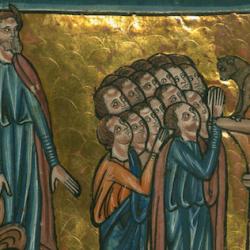The angels at the corners of the land hold back the winds that could harm the earth, sea, and trees. But they actually have authority to harm only over the first two: earth and sea (Revelation 7:2). The trees won’t be harmed by the wind in any case.
When the first trumpet trumpets, some trees are harmed – a third of them (8:7). But when the locust-scorpions are released from the abyss, they aren’t allowed to harm grass, green things, or trees (9:4). In that last passage, the green things are contrasted with those who have not received the seal of God, suggesting that trees represent the saints (as in Psalm 1).
That imagery seems to be operating already in chapter 7, which presents an unusual cosmology of “earth, sea, tree” instead of the more usual “heaven, earth, sea.” Revelation 7:2 stars in the middle of cosmos, with earth, moves down to the sea, and then, instead of the firmament or heaven, describes the upward reach of the cosmos as a “tree.” It’s possible that 6:13 is still echoing in the background, with its comparison of the canopy of a fig tree to the sky with stars.
Trees are never harmed any further in Revelation. God makes war, but He doesn’t destroy trees. Later, the saints are imagined as grain and vines (ch. 14), but they are harvested, not destroyed.
He wars according to His own rules of war: “When you besiege a city a long time, to make war against it in order to capture it, you shall not destroy its trees by swinging an axe against them; for you may eat from them, and you shall not cut them down. For is the tree of the field a man, that it should be besieged by you?” (Deuteronomy 20:19).















